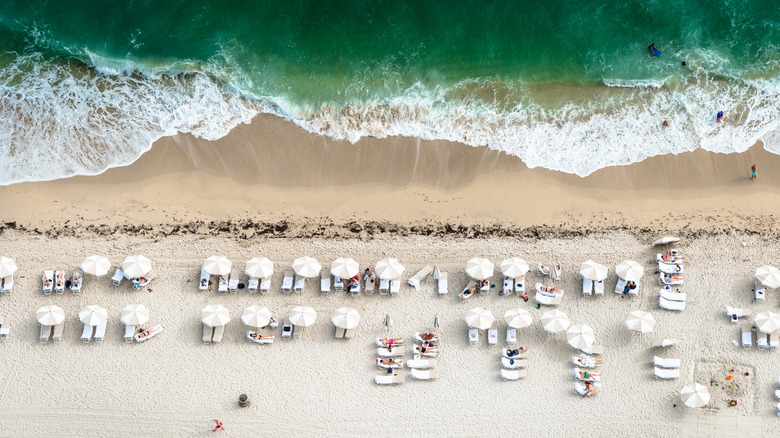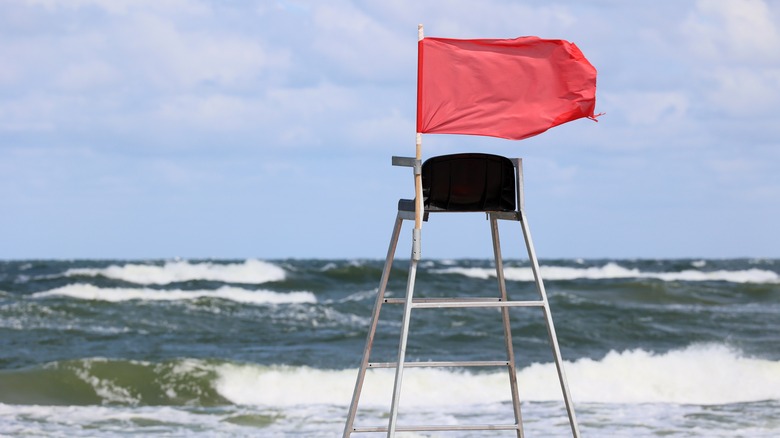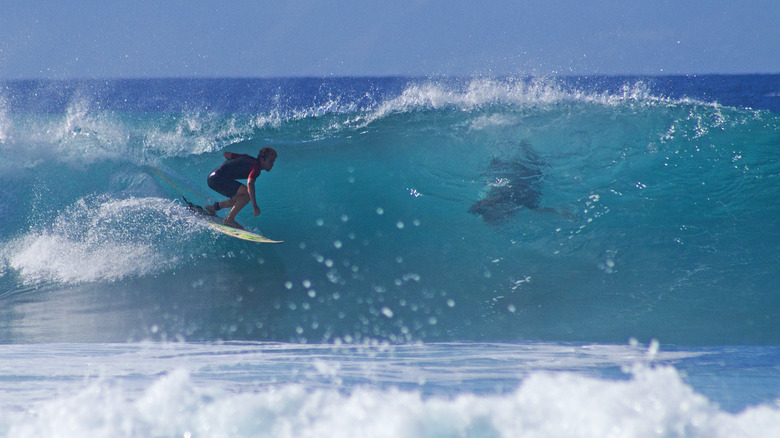The Most Dangerous Time Of Year To Swim In The Atlantic Ocean
A trip to the beach can be a relaxing time for a holiday break or a family vacation, but it's always a good idea to be aware of the risks associated with swimming in the open ocean. The strength of the surf and the crashing waves can fatigue any swimmer. Too much sun exposure can cause heat exhaustion, and dehydration can deplete a person's strength in the water. However, there is one season of the year that is particularly risky for swimmers who visit the Atlantic Ocean. Autumn is the time when visitors need to take extra precaution when visiting their favorite beaches on the East Coast. There are a number of reasons why this season is more dangerous for swimmers than any other time of the year.
Several environmental conditions overlap in the fall that can create a challenge for beachgoers. Hurricane season on the Atlantic Coast begins in early June and lasts until the end of November, and it reaches its peak between September and October. Even when a hurricane is miles from shore, it can create dangerous swimming conditions on the coast. As the winds begin to increase, the size of the waves along the shoreline increase as well. As the swells become larger, it becomes difficult for swimmers to catch their breath between waves.
Fall is hurricane season
Hurricanes also create dangerous rip currents along the shoreline. These strong currents move away from the shore in the direction of the open sea, and they are strong enough to pull swimmers out into deep water very quickly. The timing of hurricane season often means that a storm will often coincide with Labor Day weekend, when large crowds of people come to swim at the beach. Many of these visitors are unprepared to tackle these unusually strong surf conditions, and public beaches will sometimes close for safety reasons. However, the crowd of visitors can frequently outnumber the available lifeguards who patrol the public swim areas, and those who enter the water without a lifeguard present may find themselves needing emergency assistance when none is available.
One of the hazards of rip currents is that they're hard for most people to recognize from the shore, and swimmers may not be aware of them until they're caught up in one. According to the National Weather Service, approximately 80% of the rescues performed by lifeguards across the country each year are the result of a swimmer getting caught in a rip current, and they are the cause of approximately 100 drownings in the U.S. annually. In North and South Carolina, for example, rip currents are currently the leading cause of death from weather-related conditions along the coast.
Sharks migrate in the fall
Another reason that autumn is a dangerous time to swim in the Atlantic Ocean is because it is the time of year when great white sharks begin their migration south. This event coincides with the fall equinox that takes place in September. After spending the summer in waters off the coast of Newfoundland and Cape Cod, these sharks begin to move south as seasonal temperatures start to turn cooler. As they head toward warmer waters off the coast of Florida, their migration path takes them along the length of the East Coast. On their route south, they pass popular beaches in areas such as New Jersey, Virginia, and the Carolinas.
Florida, in particular, has become known as the "shark bite capital of the world" (via Fort Myers News-Press). The milder temperature of the water attracts the fish that sharks prefer to eat, and the abundance of prey can often lead to interactions with swimmers. This is one of the reasons that New Smyrna Beach on Florida's Atlantic coast has been named the deadliest beach in the U.S., with twice as many shark attacks as any other beach in the country, per Travel Lens. However, this study came to its conclusion by considering more than just shark attacks, but also the hazardous surf conditions and rip currents that accompany hurricanes. This particular East Coast beach represents the variety of environmental conditions that combine to make fall the most dangerous time of year to swim in the Atlantic Ocean.


